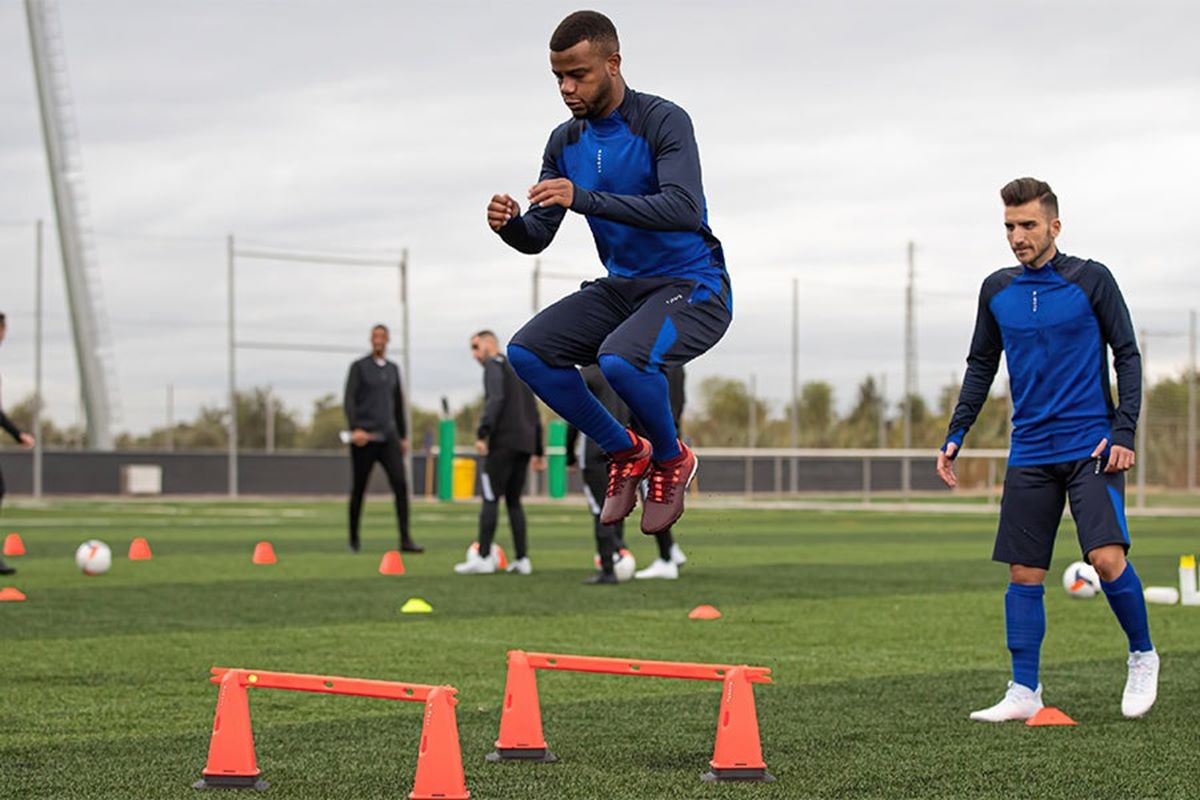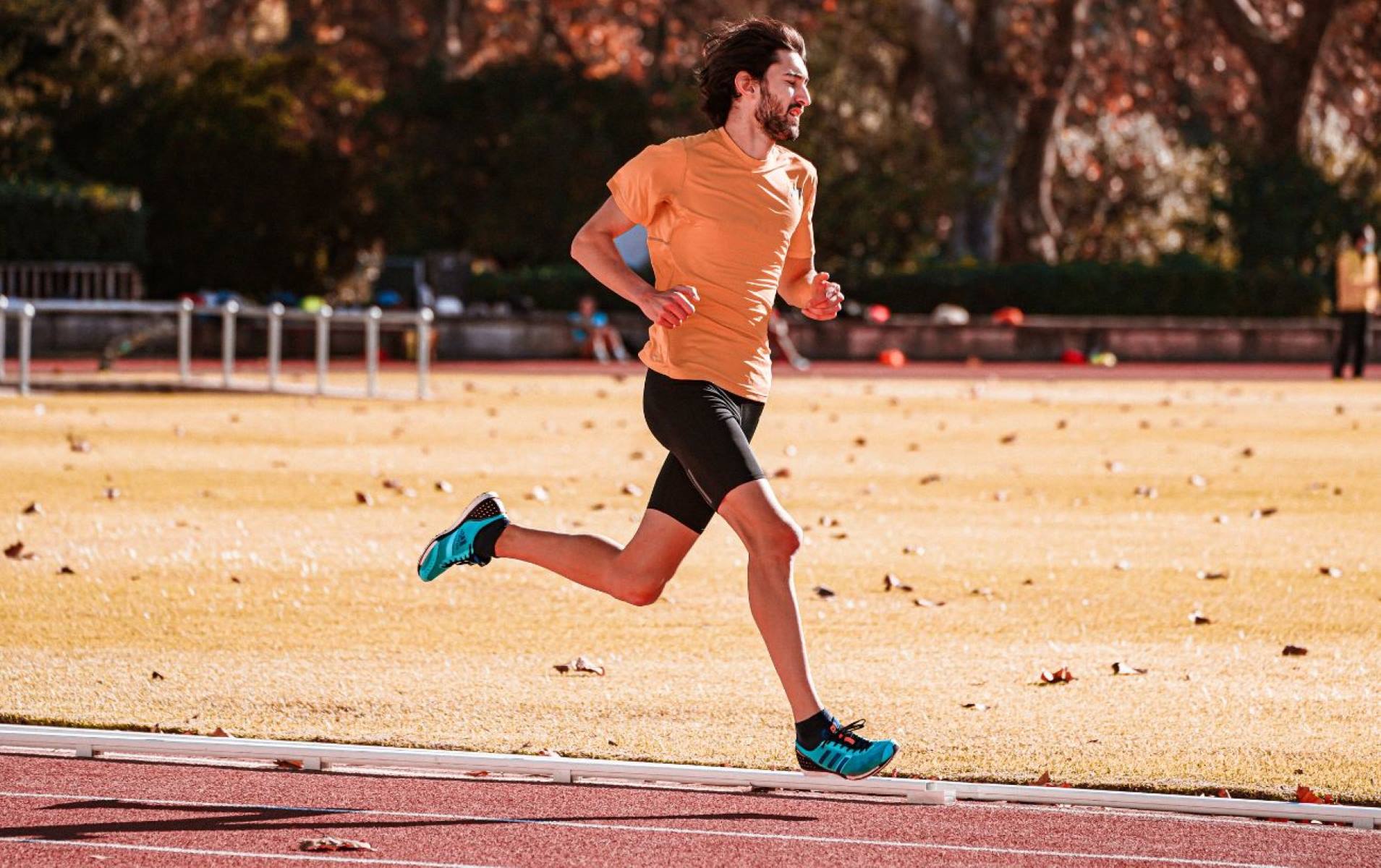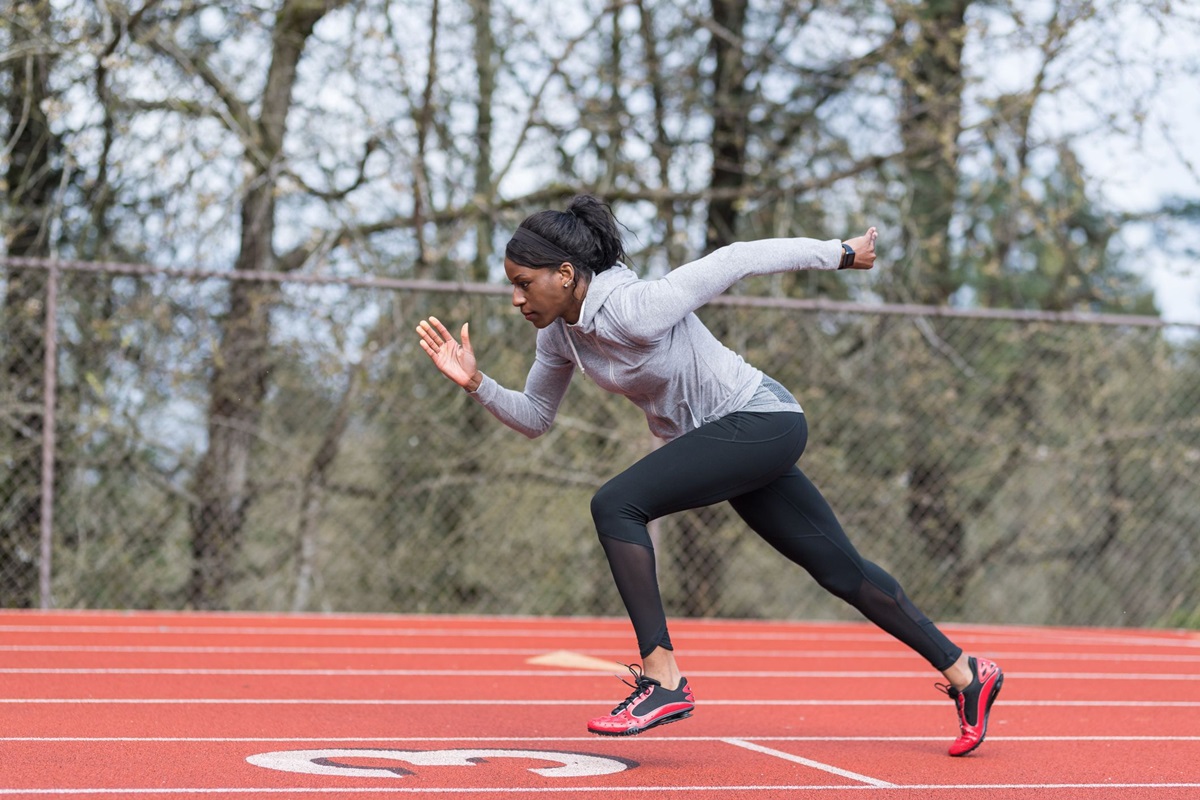

Featured
How To Improve Sprint Speed
Modified: January 22, 2024
Want to enhance your sprint speed? Check out our featured tips and exercises to improve your performance on the track.
Introduction
Sprinting is a skill that requires a combination of strength, power, and speed. Whether you’re an athlete looking to improve your performance on the track or simply someone interested in enhancing your overall fitness level, increasing your sprint speed can be a challenging yet rewarding goal.
The ability to accelerate quickly and maintain a high speed over a short distance is a valuable asset in various sports such as track and field, soccer, basketball, and football. Additionally, sprinting can help improve cardiovascular endurance and burn calories, making it an efficient way to enhance your fitness.
While genetics can play a role in determining your natural speed, there are several training techniques and strategies that can be utilized to optimize your sprinting ability. In this article, we will discuss some key factors that can help you improve your sprint speed.
It’s important to note that before embarking on any sprint training program, it is advisable to consult a healthcare professional or a qualified coach to assess your current fitness level and ensure that you are physically capable of participating in high-intensity activities.
Now, let’s dive into the various methods and techniques that can be employed to enhance your sprint speed.
Proper Warm-up
Before diving into any intense physical activity like sprinting, it is crucial to properly warm up your muscles and prepare your body for the demands of sprinting. A thorough warm-up routine helps to increase blood flow, improve flexibility, and reduce the risk of injury.
Start your warm-up with light aerobic exercises such as jogging or jumping jacks to raise your heart rate and increase blood circulation. This helps to loosen up the muscles and prepare them for more dynamic movements.
Next, move on to dynamic stretching exercises that target the major muscle groups involved in sprinting. Dynamic stretches involve moving your body through a full range of motion, which helps to improve flexibility and muscle elasticity. Perform exercises such as leg swings, walking lunges, high knees, and butt kicks to properly warm up your lower body.
After completing the dynamic stretches, it is essential to engage in specific drills that mimic the sprinting motion. These drills can include A-skips, B-skips, and bounding exercises. These drills not only enhance muscle activation but also reinforce proper sprint mechanics and technique.
In addition to physical warm-up exercises, it’s important to mentally prepare yourself for the intense sprinting session ahead. Take a few minutes to visualize yourself sprinting with perfect form, focusing on your goals and the feeling of speed and power. This mental warm-up can help improve your concentration and mindset during your sprinting sessions.
Remember, a proper warm-up routine should last about 10-15 minutes, gradually increasing in intensity. It should leave you feeling loose, energized, and mentally ready to tackle your sprinting workout.
Incorporating a comprehensive warm-up routine into your sprint training regimen is essential for maximizing performance and preventing injuries. By dedicating time to warm up your body properly, you can ensure that your muscles are prepared for the intense demands of sprinting, allowing you to perform at your best.
Strengthening Exercises
Developing strength in the key muscles involved in sprinting is crucial for improving your sprint speed. By incorporating targeted strengthening exercises into your training routine, you can enhance your power and explosiveness, leading to faster sprint times.
The primary muscles involved in sprinting include the glutes, quadriceps, hamstrings, and calves. To effectively strengthen these muscles, it is important to focus on exercises that involve both single-leg and bilateral movements.
Lunges are a fantastic exercise for targeting your glutes, quadriceps, and hamstrings. Perform forward lunges, reverse lunges, and lateral lunges to work different muscle groups and improve overall lower body strength.
Squats are another essential exercise for building leg strength. Make sure to maintain proper form, keeping your knees aligned with your toes and your core engaged throughout the movement. You can vary the squat by adding weights, doing box squats, or performing pistol squats to challenge your muscles even more.
Deadlifts are excellent for strengthening your posterior chain, including your glutes and hamstrings. Whether you choose Romanian deadlifts, sumo deadlifts, or conventional deadlifts, focus on maintaining a neutral spine and lifting with proper form to avoid injury.
In addition to these compound exercises, don’t forget to include specific exercises to target your calf muscles. Calf raises, both standing and seated, are effective for developing calf strength and enhancing ankle stability, which is crucial for explosive push-off during sprinting.
Remember, proper technique and form are vital when performing strengthening exercises. Start with lighter weights or bodyweight exercises to master the correct movements, and gradually increase the resistance as you become more comfortable and confident.
It’s also important to allow adequate recovery time between strengthening workouts. This ensures that your muscles have time to repair and rebuild, leading to increased strength and power over time. As you progress, consider incorporating progressive overload by gradually increasing the intensity or resistance of your exercises to continue challenging your muscles.
By incorporating a variety of strengthening exercises that target the key muscles involved in sprinting, you can improve your overall strength, power, and explosiveness. These gains will translate directly into faster sprint speeds and improved athletic performance.
Plyometric Training
Plyometric training involves explosive, quick movements that aim to improve muscular power and enhance the stretch-shortening cycle of the muscles involved in sprinting. By incorporating plyometric exercises into your training routine, you can develop the explosive strength necessary for faster sprint speeds.
One of the most popular plyometric exercises for sprinters is the box jump. Start by standing in front of a box or platform with your feet shoulder-width apart. Squat down, swing your arms, and explosively jump onto the box, landing softly with both feet. Step down carefully and repeat for several repetitions.
Another effective plyometric exercise is the squat jump. Begin in a squat position, then explode upwards, extending your legs and arms. Land softly back in the squat position and repeat the movement for multiple reps. This exercise targets your quads, glutes, and calves while improving your explosive power.
Depth jumps are also beneficial for developing power. Stand on a platform or box, step off, and as soon as you land, immediately jump as high as possible. This exercise helps to improve reaction time, lower body power, and coordination.
Bounding exercises are another component of plyometric training that simulate the running motion and enhance explosiveness. This exercise involves taking long strides and pushing off with each step, driving your knees and arms forward with force. Focus on covering as much ground as possible with each bound.
It is important to note that plyometric exercises are high-intensity and place significant stress on your muscles and joints. It is crucial to gradually progress the difficulty and intensity of these exercises and ensure proper form to prevent injury. Start with lower heights or distances and gradually increase over time as your strength and coordination improve.
Furthermore, plyometric exercises should not be performed on consecutive days to allow sufficient recovery time for your muscles. Allow at least 48-72 hours of rest between plyometric sessions.
By incorporating plyometric exercises into your training routine, you can develop explosive power and train your muscles to generate force more efficiently. These exercises can directly translate into improved sprinting speed, acceleration, and overall athletic performance.
Technique Improvement
Improving your sprinting technique is essential for maximizing your speed and efficiency on the track. Even small adjustments in your running form can have a significant impact on your sprint times. By focusing on key aspects of proper sprint technique, you can optimize your stride length, increase stride frequency, and minimize energy wastage.
One crucial element of sprint technique is maintaining a tall and upright posture. Keep your head up, eyes forward, and shoulders relaxed. Avoid slouching or leaning too far forward, as this can hinder your power and balance during the sprint. Maintain a slight forward lean from your ankles, allowing your body to move efficiently with each stride.
Next, focus on your arm action. Your arms play a crucial role in generating force and momentum during sprinting. Keep your elbows at a 90-degree angle, swing your arms in a front-to-back motion, and drive them forcefully alongside your body. Avoid crossing your arms across your midline or swinging them too wide as it can disrupt your balance and rhythm.
Your leg action is another important aspect of sprinting technique. Aim for a quick and powerful leg drive, with each knee driving forward and upward. Strive for a full range of motion, ensuring that your foot strikes the ground directly under your body while moving through each stride. Avoid overstriding, which can lead to braking forces and reduce your speed.
Additionally, focus on your foot strike. Aim for a midfoot or forefoot strike while sprinting, as it allows for a quicker and more efficient transfer of energy. A heel strike can cause braking forces and slow you down. Practice running barefoot on a soft surface to develop a proper foot strike and increase foot and ankle strength.
It is crucial to practice sprinting drills that specifically target technique improvement. These drills can include high knees, butt kicks, and A-skips. These exercises help reinforce proper posture, arm action, and leg drive, allowing you to ingrain correct technique patterns into your muscle memory.
For further improvement, consider working with a qualified coach or trainer who can provide expert guidance and feedback on your technique. Video analysis is also a useful tool to identify areas of improvement and track your progress over time.
Remember, improving your sprinting technique takes time and practice. Dedicate regular training sessions to focus solely on technique, gradually incorporating it into your sprint workouts. With consistent effort and attention to detail, you can refine your sprinting technique and reap the rewards of improved speed and efficiency.
Interval Training
Interval training is a highly effective method to improve sprint speed and endurance. This training technique involves alternating between periods of high-intensity sprinting and active recovery. By pushing your body to work at maximum effort during the sprint intervals and allowing for recovery periods, interval training helps to improve aerobic and anaerobic fitness, enhance speed, and increase your lactate threshold.
One commonly used interval training method for sprinting is the Tabata protocol. Tabata training consists of 20 seconds of maximum effort sprinting followed by 10 seconds of rest, repeated for a total of four minutes. This high-intensity training method is known for its efficiency in improving both aerobic and anaerobic fitness.
Another popular interval training protocol is the 30/30 method. This method involves sprinting at maximum effort for 30 seconds followed by 30 seconds of active recovery, such as jogging or walking. Repeat this pattern for a set number of repetitions or a predetermined duration. Gradually increase the number of repetitions or the duration of the intervals as your fitness level improves.
Interval training doesn’t have to be limited to running on a track. You can also incorporate interval training into other activities such as cycling, swimming, or using cardio machines like the treadmill or stationary bike.
It is important to tailor your interval training program to your fitness level and goals. Beginners may start with shorter sprint intervals and longer recovery periods, slowly progressing towards more challenging intervals as their fitness improves. Advanced athletes may incorporate longer and more intense sprint intervals to further challenge their speed and endurance.
Remember to warm up properly before starting your interval training session and cool down afterward to prevent injury and aid recovery. Additionally, proper nutrition and hydration are crucial for optimal performance during interval training.
Consistency is key when it comes to interval training. Aim to incorporate interval sessions into your training routine at least once or twice a week, allowing for adequate recovery between sessions. Over time, you will notice improvements in your sprint speed, endurance, and overall cardiovascular fitness.
Interval training is a challenging and effective method to improve sprint speed and endurance. By incorporating regular interval training sessions into your training routine, you can push your limits, increase your speed, and take your sprinting performance to the next level.
Proper Nutrition and Hydration
Proper nutrition and hydration play a vital role in improving sprint speed and overall athletic performance. Fueling your body with the right nutrients and maintaining proper hydration levels can optimize your energy levels, enhance muscle function, promote recovery, and support optimal sprinting performance.
Carbohydrates are the primary source of energy for sprinting. Consuming an adequate amount of carbohydrates before a sprint workout or competition can provide the necessary fuel for intense efforts. Opt for complex carbohydrates such as whole grains, fruits, and vegetables, which provide sustained energy release. Additionally, be mindful of your carbohydrate intake throughout the day to maintain glycogen stores for optimal performance.
Protein is essential for muscle repair and growth. Including lean protein sources such as chicken, fish, tofu, or beans in your diet can help support muscle recovery after intense sprinting sessions. Aim for a balanced distribution of protein throughout the day to facilitate muscle repair and synthesis.
Fats are also important for optimal performance and overall health. Incorporate sources of healthy fats, such as avocados, nuts, and olive oil, into your diet to provide essential fatty acids and support hormone production.
Proper hydration is crucial for optimal performance and preventing dehydration. During sprinting, you lose fluids through sweat, which can lead to decreased performance and increased risk of injury if not replenished. Drink water regularly throughout the day to maintain hydrated muscles and improve performance. During intense workout sessions, consider consuming a sports drink or electrolyte-rich fluids to replenish electrolytes lost through sweat.
Vitamins and minerals are essential for various metabolic processes and overall health. Ensure you consume a variety of fruits, vegetables, and whole foods to obtain a wide range of vitamins and minerals necessary for optimal performance. Consider speaking with a registered dietitian or nutritionist to tailor your nutrient intake based on your specific needs and goals.
Timing your meals and snacks appropriately is important for fueling your sprinting workouts. Aim to consume a balanced meal containing carbohydrates, protein, and fats about 2-3 hours before sprinting. This allows enough time for digestion and absorption of nutrients. If you’re short on time, opt for a small snack containing easily digestible carbohydrates and a small amount of protein about 30-60 minutes before your workout.
After your sprint workout, prioritize post-workout nutrition to support muscle recovery and replenish depleted glycogen stores. Consuming a combination of carbohydrates and protein within the first hour after your workout can enhance muscle repair and replenish energy stores.
Remember, every individual is different, so it’s crucial to listen to your body and adjust your nutrition and hydration plan accordingly. Pay attention to how different foods and hydration strategies affect your energy levels, performance, and recovery, and make adjustments as needed to optimize your sprinting performance.
Rest and Recovery
Rest and recovery are often overlooked aspects of training, but they are crucial for improving sprint speed and athletic performance. Sprinting places significant stress on the muscles, joints, and nervous system, and adequate rest and recovery allow for adaptations to occur and prevent overtraining.
One important component of rest and recovery is getting enough sleep. Sleep is when the body repairs and regenerates tissues, and inadequate sleep can negatively impact performance and recovery. Aim for 7-9 hours of quality sleep each night to support optimal sprinting performance.
Incorporating rest days into your training schedule is also important. Rest days allow your muscles, tendons, and nervous system to recover from the high-intensity sprinting workouts. Use this time to engage in low-impact activities such as walking, stretching, or foam rolling to promote blood flow and aid in muscle recovery.
Active recovery exercises can also be beneficial for stimulating blood flow and reducing muscle soreness. Light aerobic exercises like swimming or cycling can help flush out metabolic waste and promote muscle recovery.
Utilizing different recovery techniques can also aid in improving sprint speed. Massage, foam rolling, and other forms of self-myofascial release can help release tension in muscles and promote flexibility. Additionally, incorporating stretching exercises, particularly after workouts, can improve flexibility and reduce the risk of injury.
Nutrition plays a crucial role in recovery as well. Consuming a balanced meal or snack containing a combination of carbohydrates and protein within the first hour after workouts can enhance muscle repair and replenish energy stores. Additionally, staying hydrated throughout the day supports overall recovery and optimal performance.
Finally, remember that rest and recovery are not just physical but also mental. Taking breaks from intense training can help prevent burnout and allow you to maintain a positive mindset. Engage in activities that you enjoy outside of sprinting to keep your mind fresh and motivated.
It’s important to listen to your body and adjust your training schedule as needed. If you’re feeling excessively fatigued, experiencing persistent muscle soreness, or noticing a decline in performance, it may be a sign that you need more rest and recovery. Be mindful of pushing your body too hard without allowing for adequate recovery time.
By prioritizing rest and recovery in your training schedule, you give your body the opportunity to repair and adapt, leading to improved sprint speed, increased strength, and reduced risk of injury. Remember, rest is just as important as training when it comes to achieving your sprinting goals.
Conclusion
Improving sprint speed is a comprehensive process that requires a combination of physical training, technique refinement, and proper lifestyle habits. By incorporating the strategies discussed in this article, you can enhance your sprinting performance and achieve your speed goals.
From a proper warm-up routine to strengthen your muscles, plyometric training to develop explosive power, and focusing on technique improvement to optimize your form, each aspect contributes to enhancing your sprint speed. Interval training can further challenge your speed and improve both aerobic and anaerobic fitness.
Proper nutrition and hydration are vital for fueling your body and supporting optimal performance during sprint training sessions. Pay attention to your macronutrient intake, timing of meals, and staying adequately hydrated to optimize your energy levels and aid in recovery.
Lastly, rest and recovery should not be neglected. Getting enough sleep, incorporating rest days, and utilizing various recovery techniques allow your body to adapt, repair, and prevent overtraining. Remember that sprinting is a demanding activity that requires a balance between pushing your limits and allowing for proper rest to avoid burnout.
Keep in mind that individual progress may vary. Each person has unique fitness levels, genetic factors, and goals. It’s important to listen to your body, adjust your training as needed, and consult with a healthcare professional or qualified coach to ensure you’re training safely and effectively.
So, lace up your running shoes, implement these strategies into your training routine, and embark on the journey to improve your sprint speed. With dedication, consistency, and smart training, you’ll be on your way to achieving faster sprint times and unlocking your full athletic potential.








